-
Posts
14,343 -
Joined
-
Last visited
-
Days Won
25
Content Type
Profiles
Forums
Blogs
Gallery
Events
Store
Posts posted by Ed_Haynes
-
-
Major references for what I just posted:
Christopher Buyers, http://www.4dw.net/royalark/Jordan/jordan.htm
Flags of the World, http://www.crwflags.com/fotw/flags/hejaz.html
OMSA Medal Database, http://www.omsa.org/photopost/showgallery.php?cat=616
Megan Robertson, http://www.medals.org.uk/jordan/jordan004.htm
?Rulers?, http://rulers.org/ruli.html#iraq
?Rulers?, http://rulers.org/ruljk.html#jordan
?Rulers?, http://rulers.org/ruls1.html#saudi_arabia
?Rulers?, http://rulers.org/ruls3.html#syria
0 -
The Wisam an-Nahada / Supreme Order of the Renaissance is still awarded by King Abdullah II. In closing, the Late King Hussein and Queen Noor with their medals.

 0
0 -
This is the most common badge, and was mad in many places. As an example, this (though the ribbon has been flipped for the cased commander's badge):
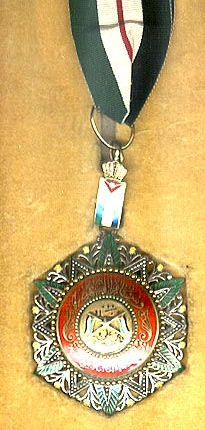
 0
0 -
The relocated order would have its badge redesigned (if necessary) to reflect the post-1921 flag (black / white / green). It woudl also be expanded into classes (although this may have taken place earlier):
--- a special class - Mourassa - Grand Cordon in brilliants - jeweled 65-mm badge (with a diamond added in the center of the badge) with sash and star ? reserved for foreign heads of state
--- Grand Cordon - sash, 65-mm sash badge, and 95-mm star (worn on the left breast) ? reserved for princes, heads of government, and others of similar rank
--- Grand Officer - 45-mm neck badge (on 38-mm ribbon) and 95-mm star (worn on the left breast)
--- Commander - 45-mm neck badge (on 38-mm ribbon)
--- Officer - 45-mm breast badge on a 38-mm ribbon with a 27-mm rosette
--- Knight - 45-mm breast badge on a 38-mm ribbon
--- silver medal - just the central circular medallion (enameled) without the surrounding star
I can show most of these classes, if anyone wishes.
In 1952, however, when the well-known King Hussein (r. 1952-99) ascended the throne, the ribbon was redesigned, to equal stripes of black, white and green; with a narrow red stripe in the centre of the white stripe.

 0
0 -
When King Ali and, by extension, King Hussein found themselves unemployed by King Abdul Aziz's victory (they would live, respectively, until 1935 and 1931), they could find both personal and dynastic refuge with family.
-- In March 1920, King Hussein's son and King Ali's brother Faysal ibn Hussein al-Hashimi had been established by the British as king of the newly created Syria. Syria, however, had been given by the British and French to the French, and the French knew full well how to deal with kings. In July 1920, King Faisal found himself slso without a job until he was reinatsllaed (again, by the British) as King of the newly created Iraq in August 1921 (he would, personnaly, continue as king until his death in September 1933, the foreign dynasty would continue until it was consumed by revolution in July 1958). It was in Iraq that the family members would take refuge.
-- In April 1921, King Hussein's son and King Ali's brother Abdullah ibn al-Husayn al-Hashimi had been established by the British as king of the newly created Emirate of Transjordan, the leftover pieces after the British had carved out their protectorate in Palestine. While his brother in Iraq got the family memers (Baghdad being a better place to live than Amman?), Abdullah got the flag and, for us the most important, orders. He adopted the Wisam an-Nahada and the Wisam al-Istiqial and traneformed them, in 1925, into Transjordanian (after 1949 Jordanian) orders.
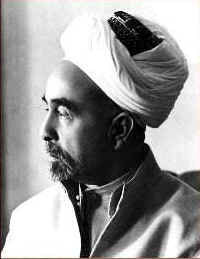
 0
0 -
King Hussein and his successor (and son) King Ali ibn Hussein (r. 1924-25) created other decorations, not directly relevant here:
--- Wisam al-Istiqial / Order of Independence (1921)
--- Ma?an Medal, 1920
--- Medal of Arab Independence
When King Hussein stepped down as King of the Hejaz in 1924, it was in part to assume the title of Caliph which he had claimed after it had been abolished by Mustafa Kemal Attaturk in Turkey and in part to assume wider rulership of a pan-Arab kingdom which he had been promised by the British for his support during the war. He also stepped down under military pressure from a rising new power in the Arabian peninsula, the King of Najd Abdul Aziz ibn Abdul Rahman ibn Faysal ibn Turki Abdullah ibn Muhammad Al Sa`ud. In 1932, Abdul Aziz would unite the Arabian peninsula into the new kingdom of Saudi Arabia. And that is quite another tale.
In March (?) 1921, the Arab Revolt/Najdi flag was altered to show horizontal black / white / green stripes and, presumably, this apperared also on the badges of the Wisam an-Nahada.
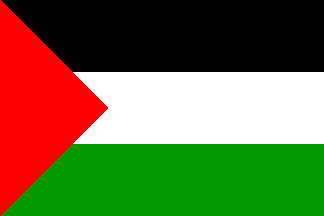
 0
0 -
The earliest badges were worn not from ribbons but from a twisted cord of black, white, red, and green. As this, obviously, did not conform to the phaleristic conventions of the British "friends" of King Hussein, a ribbon was introduced: equal stripes of black, green and white; with a narrow red stripe in the centre of the green stripe. This would be used until 1952.

 0
0 -
Note, please, the flag. It is important and diagnostic for the period and variety of the order we are dealing with.
The earliest badges have, for the horizontal stripes: Black / green / white.
Vexiology is important for phaleristics.
I do not have an image of the first badge, but this is "close", though the flag is wrong.
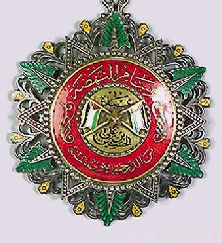
 0
0 -
The orders was created in 1917 as an award for specific services in the Arab Uprising under Grand Sherif Hussain ibn Ali in the Hijaz.
The order was a single-class (?) order with, as the obverse, an elaborate six-pointed silver star with green enamel. Between each point is a green-enameled wreath with a small yellow bud. In the center, two crossed flags of the Arab Rebellion (not Jordanian) in color on gold enamel with a star above and the Arabic inscription in black ?His [God?s] Servant Al-Hussain ibn Ali?. Around, a red-enameled band with an Arabic inscription ?Order of Al Nahda? with athe date ?1334? (A.H. = 1917 C.E.). The badge is suspended by an enameled ?Arab Revolt? flag and a small gold crown.
A digression on flags is demanded . . . .
The flag of the "Arab Revolt" was (apparently) designed by Sir Mark Sykes of the British Foreign Office, though Sherif Hussein modified the shade of red. The green is said to represent the Prophet?s banner, the white the Amawi tribe, the black the Abassi, and the red the Hashimi.

 0
0 -
The exteremely complex (and interesting) Hejai/Jordanian order, the Wisam an-Nahada / Order of the Renaissance has been raised on another thread
http://gmic.co.uk/index.php?showtopic=11855
and I thought it needed more focused attention.
It must be placed within the history of the era in which it was created. The Wisam an-Nahada / Order of the Renaissance was created in 1917 by Hussein ibn Ali al-Hashimi, who, since 10 June 1916, had named himself King of the Hejaz (the western coastal region of the Arabian peninsula). He had, since 1908, served under the Ottoman rulers of the peninsula as Grand Sherif of Mecca, but had been seduced away from that loyalty by the overly famous T. E. Lawrence "of Arabia" into a watime rebellion against Turkish rule of the Arab lands.
Sherif/King Hussein:

 0
0 -
Wow Ed,
That is a great bar!!!
 It is the first Iraqi Bar I have seen. Do you have any background information on the original owner?
It is the first Iraqi Bar I have seen. Do you have any background information on the original owner?Regards
Paul
No information, unfortunately.
 Some great service, though!
Some great service, though!  0
0 -
To "bump" this, to respond to a query raised in another thread, and to get it back on track:
An Iraqi medal group. I think you guys can identify the medals from the specimens already shown here?

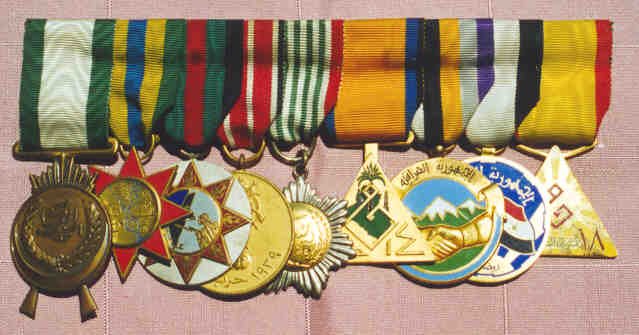
 1
1 -
Looks like a nice website, thanks OoV. I have the Rosetta Stone set for Russian and TRY, but find finite brain cells for language these days.
0 -
This is an exceedingly strange, almost bizarre, thread.
 0
0 -
Contemporary:
Mongolian Red Cross: http://www.redcross.mn/
Their awards: http://www.redcross.mn/english/awards.html
0 -
I have posted my Soviet KIA over on the other thread (well, a link to the place where it is presented in greater detail). Personally, I get confused by parallel threads and cross/double postings. But, then, I confuse easily.
 0
0 -
The 30 March 1945 POW list for Europe (only) has been reprinted in three volumes as Prisoners of War vol 1 British Army (ISBN 0-903754-61-4), vol. 2 Naval and Air Forces (ISBN 0-903754-62-2), and vol. 3 Armies and other Land Forces of the British Empire (ISBN 0-903754-63-0, the only one I have as it includes the Indian Army). These were reprinted in 1990 by J. B. Hayward and are now fairly hard to find. I got mine through Chris Dixon, but I know their stocks were low at the time. You might be able to turn up copies through http://www.abebooks.com/ I looked and found at least one copy of vol. 1 (at $125).
In some ways, the March 1945 list may not be the most useful, as many POWs (in Italy, for example) were let loose by then. Earlier lists are in the various archives. I have used a 1943 and 1944 list (I think) at the National Army Museum's library.
About all this list will give is the camp in which he was interned and the POW number (which, I'd wager, relates to some other records, whether German, Italian, or British).
I'd be surprised if much could be found online. As I tell my students (constantly) "research" is to "Google" as apples are to stones.
0 -
Much wise widsom here. Thanks, all.
One more suggestion: If there is ANY way to do so, a beginning collector should develop some degree of ability in the Russian language. Even if it is only a rudimentary knowledge of the printed Cyrillic script (handwriting is quite another matter and is a bigger challenge!) with a limited vocabulary and almost no grammar, I think some level of Russian is a vitally important part of the fledgling Russian phalerist's toolbox. Ideally, higher levels of skill in Russian should be sought. Not only are there documents and citations to read and translate, but I suspect that, twenty years from now if it is not true already, the most important sources will be in Russian. There is already the Mondovor online site and a number of very good focused books on awards like the Red Banner and Lenin. I suspect that, as we move beyond the classic and ground-breaking (I almost said "revolutionary") Red Bible, you'll need literacy in Russian to benefit much. This will reflect what we are seeing already, the emergence of a large and active ethnically and linguisitically Russian collecting community. Just as one needs German to be a serious collector of German awards in any era, Russian is very desirable for the collector of Soviet awards and, in a few years, it may be a near-necessity.
For those of us here, now, the first generation of post-Cold-War students of Soviet awards, many of us stumble along with limited or no Russian skills. Some, like me, can barely function (I and I need to take my own advice here). I can't imagine the second generation being able to do so. And how much easier would it be for us if we could read (forget conversation, which reduces the value of most CD-ROM based language teaching tools, as they focus on speaking and comprehension skills).
Learn Cyrillic, get a dictionary, learn the rudiments of grammar, and get to work! I know I am!!
 0
0 -
Smells fake/fantasy, but let me check the books to see if it is a "mule". Looks to me like Taiwanese eBay dreck.
Sorry.
 0
0 -
0
-
0
-
0
-
0
-
I just realised some of my single items (researched and unresearched, documents and undoumented) weren't shown (or cross-linked) here. Shall strive to remedy that.
First Sergeant A. V. Grebenschchikova
See: http://gmic.co.uk/index.php?showtopic=2329

 0
0





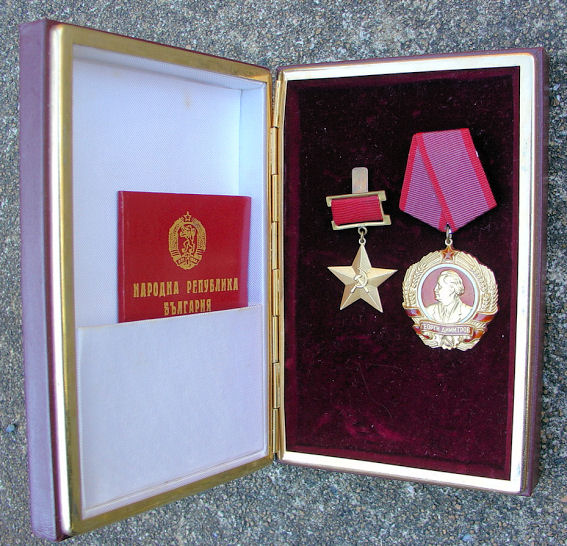
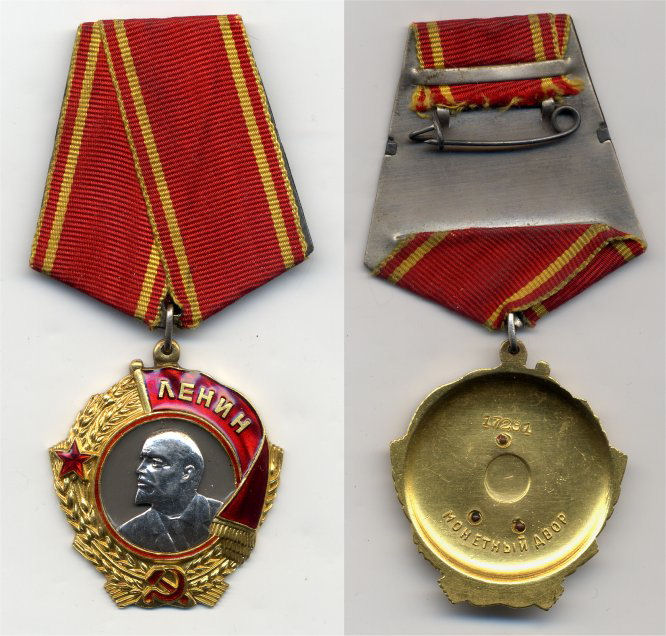
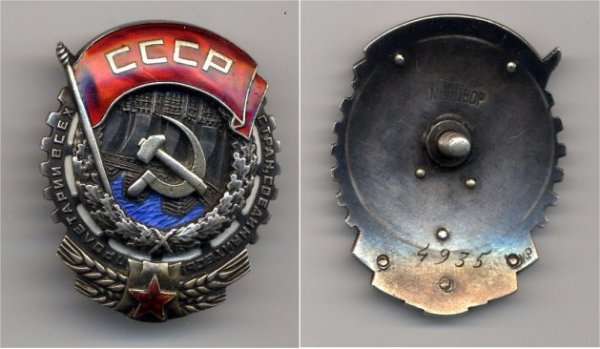

Are these being sold or is it a kind of database?
in People's Republic Mongolia
Posted
Interesting . . . though the site won't open for me . . .